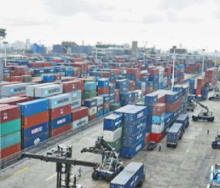The Durban Container Terminal (DCT) Pier 2 has averaged less than ten vessels at anchor over the last two weeks, having earlier ensured that all priority cargo across the retail, automotive, energy and FMCG sectors reached shelves at the required time.
This was the word from Transnet on Wednesday night in a statement updating port users on the measures the port has been taking to confront backlogs that have plagued the port for months, leading to queues of more than 20 ships waiting for days at anchor to enter the port.
However, while port users, who spoke to Freight News on condition of anonymity, have acknowledged there has been improvement in vessel turnaround time in recent days, they say the reduction of the backlogs is also related to the fact that some vessels have opted to avoid calling at Durban Port due to the recent slow service.
Durban Terminals managing executive Earle Peters said the port was working around the clock to improve efficiency.
“We are not out of the woods, but we have exceeded our set targets of clearing the vessel backlog.”
Peters added that close collaboration with shipping lines and cargo owners, as well as employee commitment, had ensured that work continued throughout the holiday season.
Original equipment manufacturers are also currently on site, providing technical support and supplying critical spares of handling equipment for repairs.
However, Peters said inclement weather had disrupted operations although contingency plans were watertight.
“We are pursuing an aggressive recovery plan, and our main focus is to relieve the pressure on our customers who rely on our service and look to us to provide much-needed value.”
According to Transnet, DCT Pier 2 has averaged 3 681 TEUs every 24 hours, with a total of 55 219 20-footers moved in the last two weeks alone, while the trucking community has kept the terminal fluid on the landside during this period.
Transnet said DCT Pier 2 continued to engage with shipping lines on the review of surcharges on import containers with improved productivity.
“We are confident that the supply chain will soon return to normality as many other processes are involved once cargo leaves the terminal,” Peters said.
He added that the rollout of the fourth shift at the terminals since December has yielded positive results.
Port stakeholders who asked not to be named agreed with Peters that there had been some improvement. However, they also raised concern that the clearing of backlogs was related to the fact some vessels had diverted their routes to exclude the port from voyages.
“Some lines have cut and run. It is a real mission to get truck appointments at both terminals, more especially at Pier 1,” said one port user.
“Currently, there are 10 ships waiting to berth at Pier 2 and probably two for Pier 1. This is excluding the number of vessels already on the berth working,” he said.













